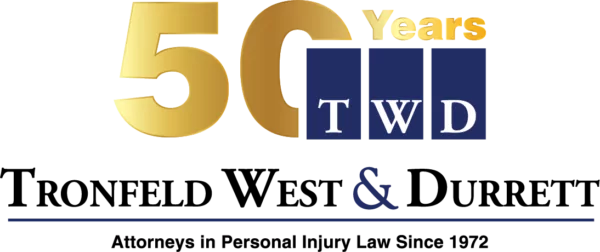Can I Be Blamed For The Accident If I Was Rear Ended?
Yes. A common belief about rear-end car accidents is that the back driver is always at fault. Typically, this idea holds true — the driver in back is the responsible party in the vast majority of rear-end collisions. And while this idea holds true in the vast majority of rear-end collisions, the circumstances of every car accident are different, and in certain situations- a driver who was rear-ended can be partially or entirely at fault. This can pose a unique challenge in Virginia, where being even one percent responsible for a crash can keep a driver from recovering damages. Below, we discuss Virginia's unique laws and describe common scenarios in which a rear-ended driver could bear liability.
Virginia's Contributory Negligence Law
When more than one driver is at fault in a car accident, most states use something called a comparative negligence law. Under this system, a driver who is 20 percent responsible for a collision can still sue the other driver for damages. If the driver wins compensation, though, his fault will reduce his settlement by 20 percent. Virginia uses a different law, called a contributory negligence law. It is much less forgiving of drivers who bear a small percentage of liability for a crash. Under Virginia's law, if a driver is even one percent responsible for an accident, he cannot recover any compensation from the other driver. The distinction between these laws often comes into play in rear-end collisions. That is because, in Virginia and other contributory negligence states, the back driver — generally the clear at-fault party — only has to prove that the front driver shoulders a tiny portion of the responsibility. If the driver can do this successfully, they can escape financial responsibility for the other driver's injuries or property damage.Virginia Rear-End Accident Statistics
According to the Virginia Department of Motor Vehicles, rear-end collisions account for a significant portion of the 128,172 traffic crashes recorded in the state in 2022, with following too closely being a leading cause. This underscores the importance of understanding liability in these accidents.Why Is the Rear Driver Usually Liable for a Rear-End Car Accident in Virginia?
In Virginia, the rear driver is typically deemed liable for a rear-end car accident due to the "rear-end presumption." This legal principle holds that the rear driver failed to maintain a safe following distance and exercise reasonable care. Here's why:- Failure to Maintain Distance: Virginia law requires drivers to keep a safe distance from the vehicle in front. If the rear driver fails to do so and collides with the vehicle ahead, it suggests negligence.
- Duty to Avoid Collisions: Drivers must operate safely and avoid collisions. A rear-end collision implies the rear driver didn't exercise caution or pay attention.
- Rebuttable Presumption: The rear driver can challenge this presumption with evidence, but the burden of proof is on them.
- Comparative Fault: Virgninia's comparative fault system means even if the lead driver shares some blame, the rear driver may still be liable, depending on the degree of negligence. In summary, while the rear driver is often considered at fault, each case's specifics determine liability.
Common Causes of Rear-End Collisions
Several factors frequently contribute to rear-end collisions in Virginia:- Tailgating: Following too closely behind another vehicle or not leaving adequate space to brake safely.
- Distracted Driving: Texting, talking on the phone, or other activities that take focus off the road.
- Speeding: Driving too fast reduces reaction time and increases stopping distance.
- Sudden Stops: Abrupt braking by the lead vehicle can make it difficult for the following driver to stop in time.
- Poor Weather Conditions: Rain, fog, and snow can increase stopping distances and reduce visibility.
- Faulty Brakes: Poorly maintained or defective brakes may fail to stop a vehicle in time.
- Impaired or Fatigued Driving: Alcohol, drugs, or fatigue can impair a driver's judgment and reaction time.
Scenarios in Which a Rear-Ended Driver Can Be At-Fault
It seems like it should be the following driver's responsibility to keep from hitting the car in front of them. And in most cases, it is. But in a few scenarios, the driver in front might be partly or wholly at fault. For instance:- The driver in front makes an abrupt and unnecessary stop, making it difficult for the trailing driver to avoid a collision even if keeping a safe following distance.
- The front driver makes a sudden lane change in front of the following driver and then hits the brakes without warning.
- The driver who was rear-ended is operating a vehicle that has faulty brake lights, impairing the driver in back's ability to detect a sudden stop.
- The driver of the rear-ended vehicle has a flat tire or other breakdown but fails to pull to the side of the road or activate his hazard lights.
Determining Fault in a Rear-End Collision
Determining fault in a rear-end collision involves several key factors. An attorney may:- Review Police Reports: These often include initial fault assessments based on the scene investigation and witness statements.
- Analyze Physical Evidence: Skid marks, vehicle damage, and debris can indicate speed, braking, and impact points.
- Interview Witnesses: Witness accounts can clarify each driver’s actions leading up to the collision.
- Examine Traffic Laws: Attorneys assess if either driver violated laws, such as tailgating or speeding.
- Investigate Distractions: Cell phone records or other evidence of distracted driving may help establish fault.
- Consult Experts: Accident reconstruction specialists may be involved to interpret evidence and offer expert opinions.
